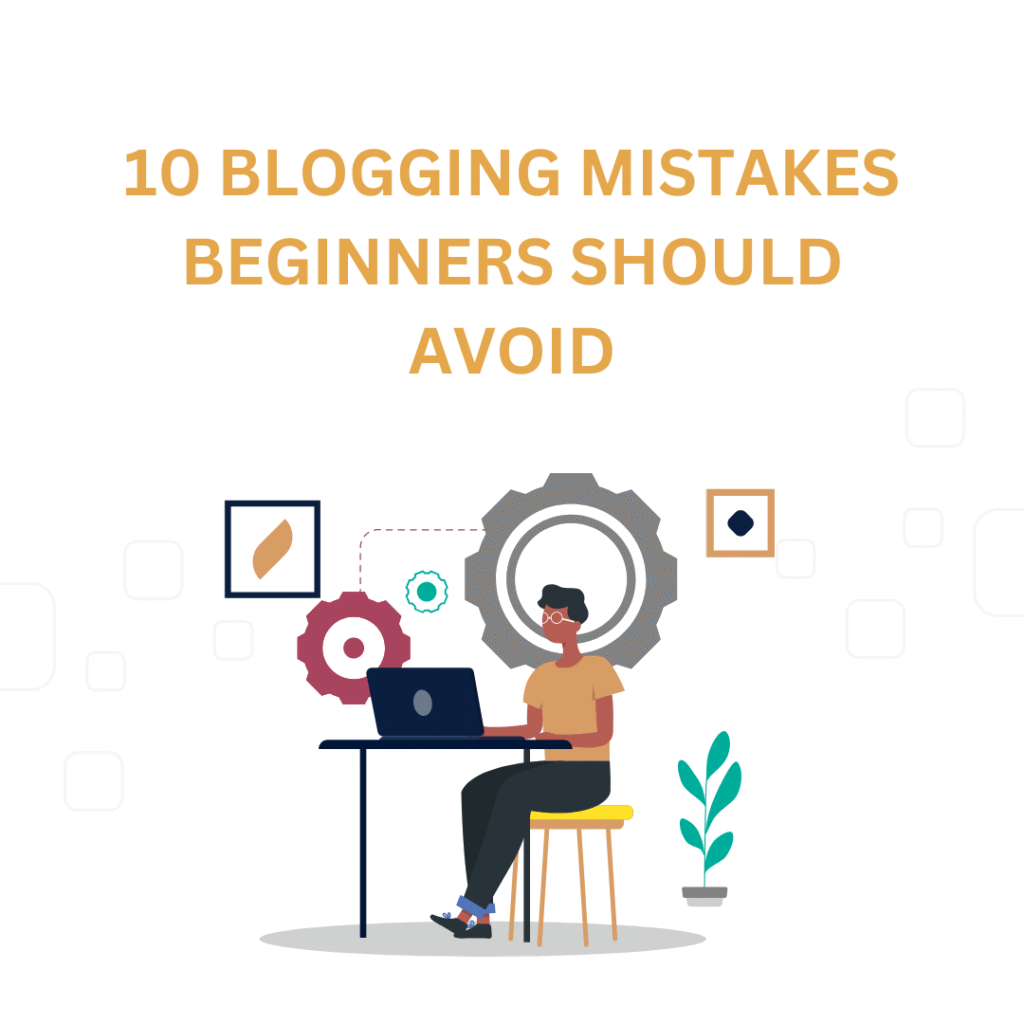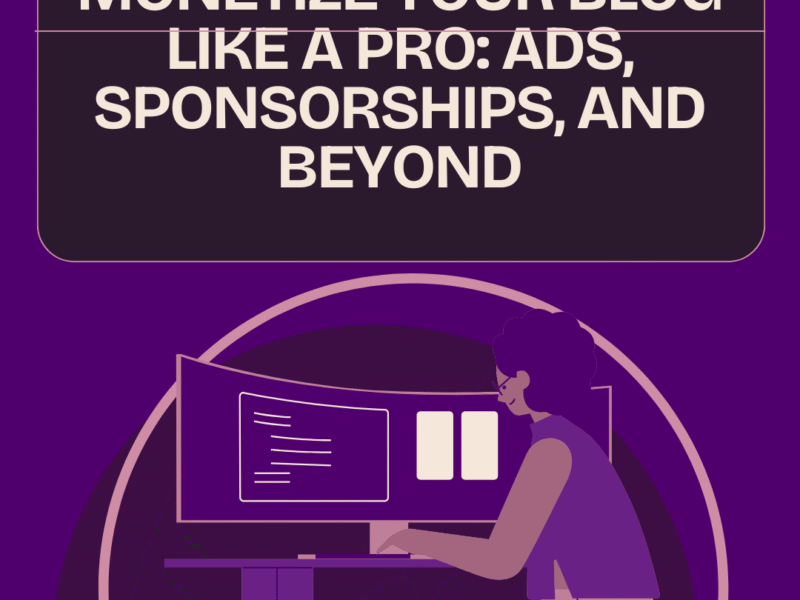10 Blogging Mistakes Beginners Should Avoid
Introduction: Why Most New Bloggers Fail and How You Can Succeed
Blogging has emerged as one of the strongest methods of expressing ideas, gaining power and generating revenue over the internet. Millions of new blogs get started each and every day with great hopes and expectations of success however very many of them fail within the first year. This is not necessarily caused by inability to be talented and passionate but by basic beginner errors which subtly destroy performance. Blogging is not only writing about what you love, but also creating a digital environment that helps maintain consistent values, audience and trust, which is based on time. You may be just a hobby writer, or you have the possibility of turning your blog into a full-time business, but this is the type of mistakes that you should know how to avoid in order to save months of frustration. The fact is, effective blogging needs strategy, patience and constancy. Most amateurs jump into the water without even thinking of the SEO, content structure and promotion strategy. When outcomes are not experienced immediately other people become discouraged. This guide discusses the top ten blogging mistakes that amateurs commit and how they can be avoided. You will end up with a roadmap that, by the end of the day, will see your blog evolve out of a struggling web site to becoming a successful online brand.
1. Not Checking on Your Target Audience
Among the initial and the most harmful errors when writing a blog, there is the tendency of not thinking whose side one is writing. Blogging is not simply a process of sharing your ideas but an act of linking with readers who need answers, encouragement or advice. By failing to specify your audience, you are too wide to narrow enough to capture the attention. The purpose of every blog post must be obvious, to benefit, inform, entertain, or inspire a given set of people. The most successful bloggers take time to do research on the niche they are in and what their audience wants, what their problem is, and what they want to know. They apply this knowledge in generating focused content, which addresses actual issues. As an example, when you are writing on the topic of fitness, you need to specify whether you are addressing beginners, busy parents, or professional athletes. Both groups possess various needs and issues. When one writes without having a specific audience in mind, the level of engagement, bounces and returning visitors are bound to be low. To correct this, make a reader person- create a single image of a perfect reader and write each post as though you are addressing the reader. Knowing your audience also benefits in the selection of the appropriate tone, style and topics. It is worth remembering that clarity creates connection and connection creates loyalty.
2. Inequalities in Posting Schedule
The secret of a successful blogging is consistency. Most novices begin with a great deal of energy and publish several articles per week, only to lose interest in the process after some days when they see no immediate increase in traffic. Irregular publishing will send a message to your audience members as well as the search engines that your blog is not trustworthy. Whenever your readers visit your site they are likely to lose interest when they find old information or large breaks between posts. Search engines are no exception since they prefer those websites which post frequently as the ability to post regularly is demonstrative of credibility and activity. It does not matter to publish every day but to make a schedule that can be realistically followed. It could be a single post per week or bi-weekly but either way, it provides rhythm and anticipation. It also assists you in planning, researching better and quality improvement. Your best friend can be a content calendar; it will assist you in organizing the thoughts and balancing between the topics. Blogging is not a race but a marathon. Consistency is what keeps your blog active, your authority growing and signals that you are professional. The more you are consistent, the greater your audience will be.
3. Neglecting SEO
SEO (Search Engine Optimization) is the key that is usually missing in a newcomer blogging strategy. It is not enough to write great content and have no one be able to find the content. The power of SEO is ignored by many new bloggers as it seems to be too technical and is not necessary. However, the fact is that SEO is merely concerned with ensuring the increased visibility of your content. In its absence, your posts will never be seen in Google search pages, however valuable they could be. SEO entails application of appropriate keywords, optimization of headlines, meta descriptions, faster loading speed and backlinks. When properly carried out, it can help to push thousands of free traffic to your site. Not using SEO will be as equivalent to putting your money on your social media or a lottery to get readers. There is no problem with getting down to the basics of SEO, as there are numerous free tools and tutorials to assist you. Begin with the research of the keywords in your niche with the help of such tools as Google Keyword Planner, Ubersuggest, or Ahrefs. Embark these keywords organically in your headings, introduction and conclusion. Keywords stuffing is to be avoided, but relevancy and readability should be considered. Good SEO habits are compounding, so in the long term your blog has long term visibility and growth.
4. Poor Blog Design and User Experience
The look and feel of your blog are the most important aspect to give a visitor’s first impression and first impressions definitely count. A lot of newcomers take the design and usability as not so important factors in the process of building trust. An unattractive, slow or old-fashioned website can scare away surfers even before they are exposed to your text. User experience (UX) consists of layout, colors, font, navigation, and mobile. Today the majority of web users are people with smartphones, therefore, a mobile-friendly website is a must. The intention of design is not only to be visually appealing but also to make your content easy to access and consume. The use of white space, clear headings, and logical structure gives comfort in reading. Don’t use eye-catching pop-ups or too many advertisements that consume your message. The design should lead the readers gently from one article to another and thus invite them to stay longer. Good UX shows an improvement in your SEO, as search engines give priority to websites that users find helpful and accessible. Investing time in making a clean, responsive design is an indicator of professionalism and also helps in enhancing the brand identity. Always remember that your blog is your digital home — make it inviting, structured, and easy to roam around.

5. Not Promoting Your Content
Thinking that “if you write it, they will come” is another mistake that is very common among the writers. To put it bluntly, excellent content does not get its readers automatically. In many cases, writers publish their new articles but do not promote them properly. Therefore, the creation of the content must be cared for along with its elicitement. If not publicity would make your rather hard work invisible. Distribute your published works through various channels — social network sites, email announcements, discussion boards, and blogging societies. Transforming content into short videos materials, diagrams, or quotations would be a successful way of attracting more diverse audiences. Acquiring links from trustworthy sites also helps in visibility and ranking. Writing a post on another blog within your niche would bring some new readers to your blog.
6. Writing for Yourself, Not the Reader
The shift in mindset of bloggers to think that the blogging is not about them but about their readers, is one of the biggest. As a result, most novice bloggers consider their websites as personal diaries and write about their random thoughts without even caring if there are any readers who want to learn or gain something from it. Authenticity is required, nevertheless; readers will visit your blog to get solutions, advice or inspiration. If every posting is about your experience with no clear deduction, then the interaction will remain low. Being indicative, rather, write more valuable content. Each and every article should ask a question, give a solution, or provide a viewpoint. The storytelling technique is effective when used wisely — tell your personal stories to demonstrate lessons that your audience can learn. Writing for the audience also means, using explicit, conversational language rather than jargon or fluff. Also, short paragraphs should be maintained, and a call-to-action or a takeaway should be given every time. Once the readers feel understood, they come back. It is this emotional connection that turns the occasional visitors into die-hard fans. Always remember that: the first person to write for is the audience, and then the writer.
7. Skipping Keyword Research
The basis of organic traffic is keyword research but still, many beginners completely neglect it. They write about what they like instead of what the people are really searching for. Not doing keyword research means you might be making content no one will ever find. Keywords are the reflector of user intent — they indicate what it is the target audience wants to know. By creating content around those search terms, you will be able to draw in the right visitors. Tools like Google Trends, SEMrush, and AnswerThePublic can be of great help in pinpointing the keywords that have a high search volume but low competition. After identifying the appropriate keywords, make use of them in an order, i.e., first in title and then in introduction, subheadings, and throughout the post. This will assure the search engine
8. Ignoring Analytics and Feedback
Many novice bloggers don’t keep track of their performance. They write and post articles but never try to figure out what appeals to the reader and what doesn’t. When you neglect analytics, you are not doing analytics. Google Analytics, Search Console, and even the most basic social media insights can reveal where your traffic originates, what posts are the most engaging ones, and which areas need improvement. Analyzing data helps to develop the blogging strategy gradually. If one subject attracts more viewers or engagement, it is wise to produce more content on it. If some posts are getting a lot of bounce traffic, then it is better to work on their format or readability. The input from readers is also very much appreciated — through comments, emails, and social interactions, the bloggers get to know what the audience likes the most. The savvy bloggers follow these signals and eventually get to the top much quicker and with greater intelligence. Successful bloggers look at analytics as a co-pilot rather than a burden. Knowing the behavior of your audience better, you can cater to their needs even more effectively. The process of continuous improvement driven by data is what distinguishes the successful blogs from the unsuccessful ones.
9. Not Building an Email List
An email list is one of the most powerful tools a blogger can have. However, still, many beginners do not pay attention to it. Often, social media platforms will change their algorithms and that will have an impact on how many people see your posts—what really matters is that your email list, however, is under your control. Building a list allows you to communicate directly with your readers, promote new content, and nurture relationships. Many new bloggers assume it’s unnecessary until they realize how valuable loyal subscribers can be. Even a small list of engaged readers can drive traffic, sales, or leads. Start collecting emails from day one using opt-in forms, lead magnets, or free resources. Offer value in exchange — such as a guide, checklist, or mini-course. Once subscribers join, send consistent newsletters that provide helpful insights rather than just self-promotion.
10. Giving Up Too Soon
The final mistake, which is also the most painful one, is giving up too soon. Blogging success is not something that happens overnight. It really takes months, sometimes even years, of hard work before one can see the results. A lot of beginners give up after a few months when the traffic is low or the income is not what they expected. What these people dont realize is that blogging is like growing plants – results come little by little. Each post you publish gives you credibility; every reader interaction adds trust. The secret is to be patient and to give it time. Even the most famous bloggers took years of slow growth to reach their breakthrough moments. Instead of quitting, figure out what’s not working, adapt your strategy and continue. Rejoice at small milestones such as getting your first 100 subscribers or 1,000 views. Blogging is a learning process that involves creativity and resilience. The more you are consistent, the more your chances of success are. Always bear in mind that in the blogging world, it is persistence that separates dreamers from achievers.
Conclusion
No blogger goes beyond the beginner stage, and thus, making mistakes is inevitable in the learning process. What is crucial is to spot such mistakes while they are still small and use them as a ladder to climb up in terms of skill and knowledge. Blogging success is a combination of being clear, consistent, and committed. By not committing such ten common mistakes as; not knowing your audience, inconsistency in posting, no SEO, bad design, no promotion, no helpful writing, no keyword research, no analytics, no emails, and quitting too early, one automatically positions himself/herself for success that lasts. The foundation you build gets stronger with every correction made. So, keep learning, keep improving, and above all, keep in mind that every successful blogger has been exactly where you are now. What has changed is the degree of persistence, planning, and zeal.


